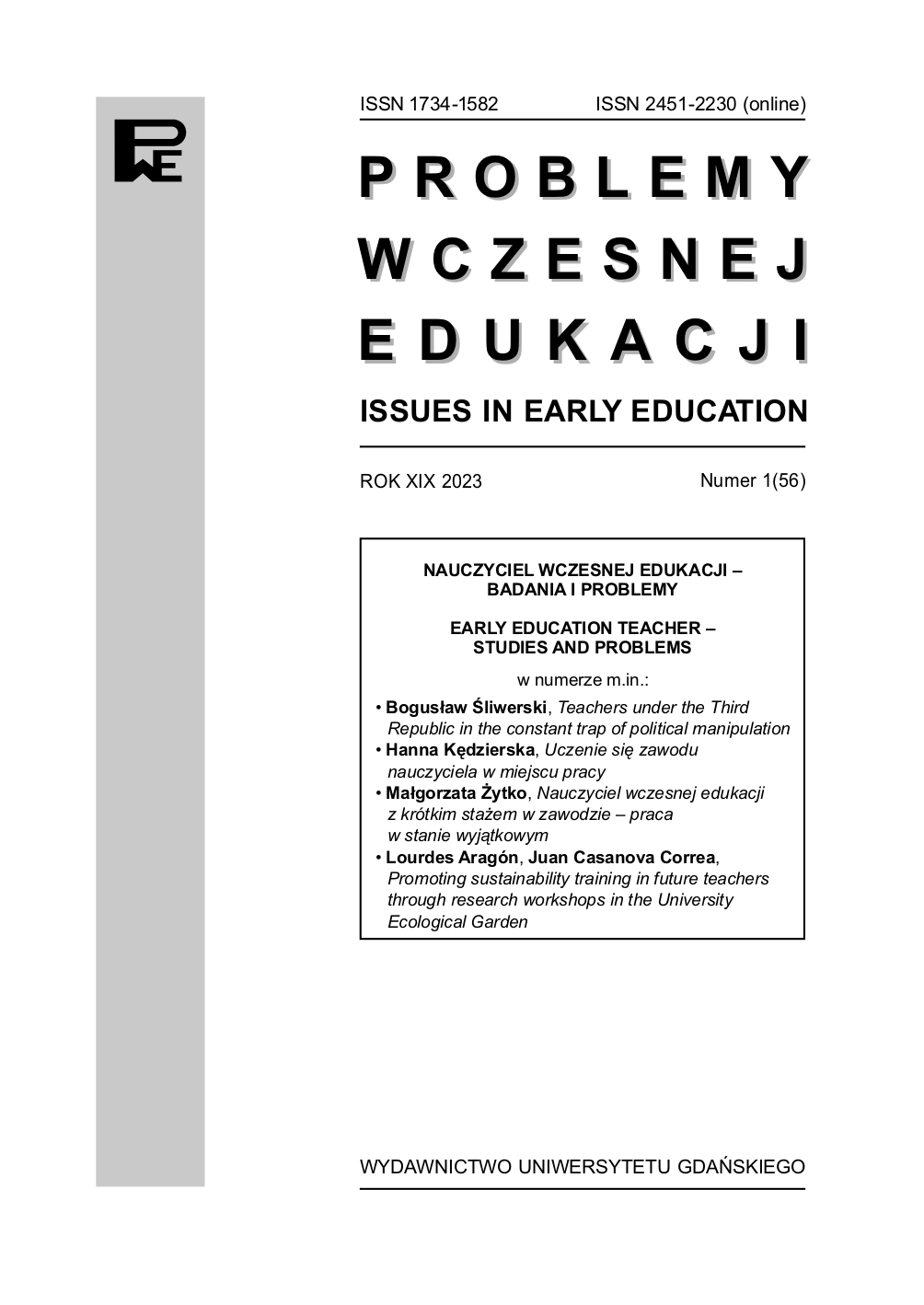Rola nauczyciela w zintegrowanym nauczaniu przedmiotowo-językowym (CLIL) na I etapie edukacji wczesnoszkolnej z perspektywy dzieci
DOI:
https://doi.org/10.26881/pwe.2023.56.13Słowa kluczowe:
edukacja wczesnoszkolna, CLIL, rola nauczyciela, edukacja dwujęzyczna, dzieci w edukacji wczesnoszkolnejAbstrakt
As a result of increasing globalization, the ability to communicate in foreign languages is a basic skill of modern times. Integrated subject-science teaching is a method of teaching that allows students to learn knowledge and language at the same time. The article presents the profile of CLIL teachers in Poland. In addition, the author carried out qualitative research using an uncategorized interview questionnaire with students (n = 25) aged 7–8 years The analysis of the answers and conclusions from the collected material showed the role of the teacher in CLIL education.
Downloads
Bibliografia
Ball P.K. (2015), Putting CLIL into practice. Oxford, Oxford University Press.
Bialystok E. (2017), The bilingual adaptation: How minds accommodate experience. „Psychological Bulletin”, 143(3).
Brzosko-Barratt K. (2019), Designing a pre-service CLIL teacher education program. „Kwartalnik Pedagogiczny”, 253(3).
Coyle D. (2005), Planning tools for teacher. Nottingham, University of Nottingham.
Cummins J. (1979), Cognitive/Academic language proficiency, linguistic interdependence, the optimum age question and some other matters. Working Papers on Bilingualism (19). Toronto, Ontario Institute for Studies in Education.
Cummins J. (1981), The role of primary language development in promoting educational success for language minority students. W: California State Department of Education (ed.), Schooling and language minority students: A theoretical framework. California, CA, Evaluation, Dissemination and Assessment Center, California State University.
Cummins J. (2008), BICS and CALP: Empirical and theoretical status of the distinction. W: Encyclopedia of language and education. New York, Springer Science, Business Media LLC.
Dale L., Tanner R. (2012), CLIL Activities. A resource for subject and language teachers. Cambridge, Cambridge University Press.
Genesee F., Hamayan E. (2016), CLIL in context practical guidance for educators. Cambridge, Cambridge University Press.
Graaff de R., Koopman G.J., Anikina Y., Westhoff G. (2007), An observation tool for effective L2 pedagogy in Content and Language Integrated Learning (CLIL). „The International Journal of Bilingual Education and Bilingualism”, 10.
Jäppinen A.K. (2005), Thinking and content learning of mathematics and science as cognitional development in Content and Language Integrated Learning (CLIL): Teaching through a foreign language in Finland. „Language and Education”, 19.
Klus-Stańska D., Nowicka M. (2005), Sensy i bezsensy w edukacji wczesnoszkolnej. Warszawa, WSiP.
Laws S., Mann G. (2004), So you want to involve children in research? A toolkit supporting children’s meaningful and ethical participation in research relating to violence against children. Sztokholm, Save the Children Sweden.
Mehisto P., Marsh D., Frigols M.J. (2008), Uncovering CLIL: content and language integrated learning in bilingual and multilingual education. Oxford, Macmillan Education.
Muszyńska B. (2019), Soft CLIL Programme. Program nauczania języka angielskiego dla szkoły podstawowej dla I etapu edukacyjnego. Warszawa, Ośrodek Rozwoju Edukacji.
Reljić G., Ferring D., Martin R. (2015), A meta-analysis on the effectiveness of bilingual programs in Europe. „Review of Educational Research”, 85(1).
Szpotowicz M., Szulc-Kurpaska M. (2009), Teaching English to Young Learners. Warszawa, Wydawnictwo Naukowe PWN.
Ziółkowski P. (2015), Teoretyczne podstawy kształcenia. Bydgoszcz, Wydawnictwo Wyższej Szkoły Gospodarki w Bydgoszczy.
Źródła internetowe
Parr-Modrzejewska A., Szubko-Sitarek W. (2016), Dlaczego warto integrować treści przedmiotowo- -językowe w szkole. „Języki Obce w Szkole”, 3. https://jows.pl/brepo/panel_repo_files/2022/11/ 24/qtnf3e/jows-1-2019-parr-modrzejewska-szubko-sitarek.pdf, 15.03.2023.
Pawlak M. (2015), Raport ewaluacyjny. Edukacja dwujęzyczna w polskich szkołach. Warszawa, Ośrodek Rozwoju Edukacji. https://www.ore.edu.pl/wp-content/plugins/download attachments/ includes/download.php?id=3126, 20.03.2023.

 Uniwersyteckie Czasopisma Naukowe
Uniwersyteckie Czasopisma Naukowe





